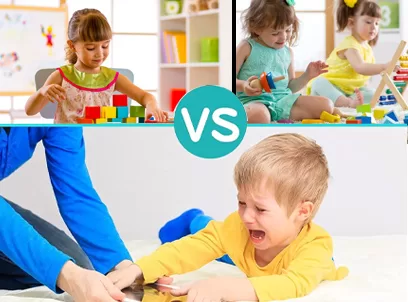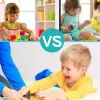
Educational Toys VS Screen Time – What’s Best for Your Child’s Development?
Parenting in the digital age comes with its set of challenges. With the influx of screens, apps, and online games, it’s easy to question: How much screen time is too much? And where do traditional educational toys fit into this modern puzzle? Join us in this parent-friendly guide as we compare educational toys and screen time.
Why Limit Screen Time?
- Cognitive Development: Excessive screen time can impede the development of critical thinking and problem-solving skills. Traditional play, on the other hand, promotes these essential cognitive skills.
- Social Skills: Physical play encourages children to interact with their peers, honing their social skills. Staring at a screen doesn’t offer this kind of rich interaction.
- Health Concerns: Over-reliance on screens can lead to sedentary lifestyles, impacting physical health, issues like reduced attention spans, disrupted sleep, and a lack of physical activity. It’s essential to strike a balance.
The Power of Educational Toys
Interactive Learning Toys: These toys are made to spark a child’s interest. They encourage kids to actively play and think. For parents who want their kids to develop good thinking skills and stay actively engaged, these toys are a top choice. They’re a great way to balance out screen time and ensure kids are really learning while they play.
Encouraging Hands-On Play: Classic toys like building blocks and art materials inspire a child’s imagination. By physically interacting with these toys, kids can directly connect with their creative ideas, making playtime both meaningful and imaginative.
Holistic Development: Educational toys often require a blend of mental and physical involvement, ensuring a well-rounded developmental experience.
Boosting Social and Cognitive Skills: Board games, role-playing sets, and collaborative toys help kids understand teamwork, empathy, and strategy. They learn to share, wait their turn, and think ahead.
The Benefits of Balancing Both Worlds
- Setting Boundaries: It’s essential to set specific screen time limits. This balance ensures kids get the best of the digital world without losing touch with real-world experiences.
- Choosing Quality Over Quantity: Not all screen time is bad. Educational apps can be beneficial, but they should complement, not replace, interactive learning toys.
- Promote Outdoor Play: Encourage activities that involve both mind and body. This approach not only limits screen time but also boosts physical health and social interaction.
- Family Time: Board games and group activities with educational toys can be an excellent way for the family to bond, ensuring children get the best of both worlds.
While we can’t entirely escape the digital realm, understanding the profound impact of educational toys can help parents make informed decisions. It’s not about completely sidelining screens but recognizing the invaluable benefits of hands-on play. By intertwining the digital with the tangible, we can ensure our children receive a balanced, enriching, and holistic developmental experience.
Remember, every child is different. What works for one might not work for another. The key is to observe, understand, and adapt, ensuring your child gets the best of both worlds. Let’s make choices that equip them with the skills, creativity, and resilience they need for a bright future.







